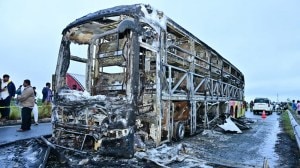Survey: Some infra growth ‘remarkable’
The Economic Survey 2011-12 said delay in infrastructure projects may affect competitiveness of the economy in long run and called for and "new models of financing" the sector whose funding requirement in the 12th Plan is estimated at around USD 1 billion.
The Economic Survey 2011-12 said delay in infrastructure projects may affect competitiveness of the economy in long run and called for and “new models of financing” the sector whose funding requirement in the 12th Plan is estimated at around USD 1 billion.
“In view of the massive requirement of funds,all efforts need to be made to attract big-ticket long-term investors such as strategic investors,private equity funds,pension funds,and sovereign funds,” the Survey tabled in Parliament today said.
It added that “there is a need for introducing more innovative schemes to attract large-scale investment into infrastructure…Strengthening domestic financial institutions and development of a long-term bonds market may be critical”.
Stating that 50 per cent of the projected investment will come from the private sector in the next Five Year Plan,the survey said,”financing infrastructure will,therefore,be a big challenge in the coming years and will require some innovative ideas and new models of financing”.
Taking a cue from the realisation of investment targets for infrastructure during the current Plan,the survey expressed hope that financing of the ambitious 12th Five Year Plan investment target would be possible.
According to the survey,the bank credit to the projects in the sector had witnessed a healthy growth of 48.4 per cent per annum during 2006-11,increasing from Rs 30,286 crore during 2006-07 to Rs 146,767 crore during 2010-11.
However,the credit growth has turned negative in the current financial year and at Rs 70,155 crore,net credit to the infrastructure sector during April-December 2011 was nearly 61 per cent lower than the same period of last fiscal,it noted.
The survey also called for “a conducive environment for private sector participation with a transparent and credible regulatory mechanism” for financing the infrastructure projects,so that to reduce the pressure on public-sector funding.
Emphasising that the performance in core infrastructure sectors is still to a large extent dependent on public sector projects,it said that in the next Five Year Plan,the public sector investment will need to increase to over Rs 22.5 lakh crore,a rise of over 71 per cent than the current Plan.
Noting that out of 583 projects in different infrastructure sectors,235 are delayed as on October,2011,and have seen cost overrun of 15.3 per cent cumulatively,the survey said that the sector has also suffered due to a time lag in the physical capacity creation and time overruns.
“These not only delay availability,but through cost overruns raise pricing and affordability issues.
Infrastructure costs,as these are often non-tradeables,may also affect the competitiveness of economy in long run,” it further said.
The original cost of the 583 projects when sanctioned was Rs 7,12,812 crore but this was subsequently revised to Rs 8,21,665 crore,implying a cost overrun of 15.3 per cent,the survey said.
It further said that maximum number of projects delayed relate to road transport and highways (90) followed by power (45),petroleum (29),railways (26),and coal (17).
“Such delays increase project risks and costs and could be minimised,” the survey said.
It noted that in the majority of cases,the delays are mainly due to a dismal record of project implementation starting from project identification,designing procurement and ineffective project monitoring.
Stating that the performance of various infrastructure sectors in 2011-12 present a mixed picture,the survey noted that only seven projects are ahead of schedule and 175 projects have been sanctioned without any specific schedule of commissioning.
“A harmonised list of main sectors and sub-sectors of infrastructure approved by the government to serve as a guide for all agencies responsible for supporting infrastructure is a welcome move,” it said.
Sectors like power,petroleum refinery,cement,railway freight traffic,passengers handled at domestic terminals and upgradation of highways have been growing in the current fiscal,while coal,natural gas,fertilisers,export cargo at airports,and the number of cellphone connections showed negative growth,the survey said.
It added that roads and highways sector is yet to achieve the target of 20 km roads a day due to delays in land acquisition and environmental and forest clearances,labour issues and and local law and order problems.
“Several initiatives have been taken for resolving these issues and it is expected that during the 12th Plan road construction work will pick up,” it added.
Read Full Report
The Economic Survey 2011-12 tabled in Lok Sabha today by the Finance Minister Pranab Mukherjee,says that the overall performance in creation of infrastructure in physical terms,in some sectors,during Eleventh Five Year Plan,have been remarkable as compared to the previous Five Year Plan,though there have been slippages in some sectors.
The success in garnering private sector investment in infrastructure through the public-private partnership (PPP) route during the Plan has laid solid foundation for a substantial step in private-sector funding in coming years. PPPs are expected to augment resource availability as well as improve the efficiency of infrastructure service delivery.
The Planning Commission has projected an investment requirement of over Rs. 45 lakh crore (about US $ 1 trillion) during the Twelfth Plan (2012-12). It is projected that at least 50% of this investment will come from the private sector as against the 36% anticipated in the Eleventh Plan and public sector investment will need to increase to over Rs.22.5 lakh crore as against an expenditure of Rs. 13.1 lakh crore during the Eleventh Plan. Financing infrastructure will,therefore,be a big challenge in the coming year and will require some innovative ideas and new models of financing,says the Survey.
The Survey has pointed out that the performance of broad sectors and sub sectors in key infrastructure areas in the current year presents a mixed picture. There was improvement in growth in power,petroleum refinery,cement,railway freight traffic,passenger handled at domestic terminals and upgradation of NHAI. Coal,Natural Gas,Fertilizers,handling of Export Cargo at airports and number of cell phone connections show negative growth. Steel sector witnessed moderation in growth.
According to the Survey,the performance in core and infrastructure sector is still to a large extent dependent in public sector projects the flash report for the month of October 2011 tracks the progress report of 583 projects in different sectors of which-only 7 are a head of schedule,166 are on schedule,235 are delayed and remaining 175 projects have been sanctioned without specifying any commissioning schedule. This has implied of cost over run of 15.3%. The Survey says that such delays increase project risk and cost,and could be minimized.
As per to the Survey,credit growth to the infrastructure sector turned negative in the current financial year. The incremental credit flow to the infrastructure sector during April-December 2011 was nearly 61% of the credit to this sector during April-December 2010.
A significant reduction in credit flow was observed for the power and telecom sectors. The total FDI inflows into majors infrastructure sectors during April-December 2011 however,registered a growth of 23.6% as compared to the FDI inflows during April-December 2010. Power (43.6%),Non Conventional Energy (338 %) and Telecommunications (499%) were the preferred sectors for foreign investors. Other sectors,however,failed to share the buoyancy in FDI inflows.
The Survey has commented that in the coming years,financing of infrastructure also need to consider the plateauing of the domestic savings and macro availability of resources. There is need for introducing more innovative schemes to attract large-scale investment into infrastructure. In view of the massive requirements of funds,all efforts need to be made to attract big ticket long-term investors such as strategic investor,private equity funds,pension funds,and sovereign funds. Strengthening domestic financial institutions and development of a long-term bonds market may be critical.
Besides financing,the infrastructure sector has also suffered due to a time lag in physical capacity creation and time over-run. These not only delay availability,but also raise pricing and affordability issues. Infrastructure costs as these are often non-tradable may also affect competitiveness of economy in long run. The Survey has stated that a harmonized list of main sectors and sub-sectors of infrastructure approved by the Government to serve as a guide for all agencies responsible for supporting infrastructure,is a welcome move. (Courtesy: PIB)






- 01
- 02
- 03
- 04
- 05

























